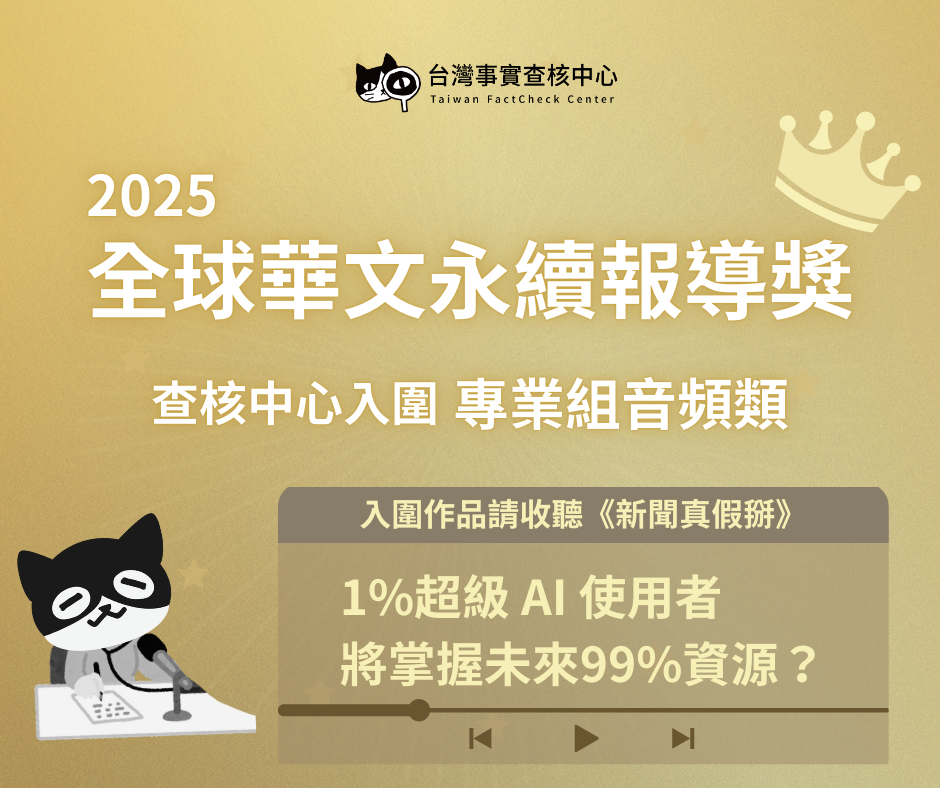Community colleges provide courses to raise media literacy among older adults
Community colleges provide courses to raise media literacy among older adults
Disinformation and misinformation are everywhere, and older adults genuinely struggle with being able to identify what stories are true versus what stories are fabricated, possibly because they are less digitally literate compared to younger individuals.
Interventions for older adults have emerged to improve media literacy, through different interactive workshops provided by various community colleges across the country to make learning easier.
Yang Chih-pin (楊志彬), secretary-general of the National Association for the Promotion of Community Universities (NAPCU), recently spoke about the efforts to promote media literacy in a podcast hosted by the Taiwan FactCheck Foundation. The interview was also joined by two local community college teachers Cheng Mei-li (鄭美里) and Yen Chin-chih (延金芝) to share their experiences with listeners.
Yang Chih-pin, secretary-general of the National Association for the Promotion of Community Universities (NAPCU) spoke about the efforts to promote media literacy in a podcast hosted by Chao-hui Huang, the former Education Director of the Taiwan FactCheck Foundation.
Disinformation in LINE groups
LINE is a popular app-messaging tool that many middle-aged and elderly Taiwanese use as their main source of information.
Students and teachers in community colleges often forward messages and submit their homework or assignment via LINE group chats, which might comprise not only of students but also their friends and family members who join in on the discussions, Yang said.
Due to the complexity of these networks, group chats can become dangerous platforms for the spread of false information, he said, but explained that if members are provided with relevant awareness-building initiatives on being vigilant, the spread of misinformation and disinformation can be minimized to some extent.
Teachers at local community colleges have been using LINE as a platform for integrating courses on raising media literacy among students, according to the NAPCU.
There are currently 89 community colleges in the country, providing a slew of courses for adults interested in lifelong learning and various civic issues, Yang said, indicating that many of these courses also integrate digital literacy into their curricula.
About 450,000 students are currently taking courses provided by these institutions.
A community college teacher chose a picture book about rumors to lead the students to discuss misinformation in her class “Picture Books for Adults”, encouraging her students in critical thinking. (Photo courtesy: National Association for the Promotion of Community Universities)
Sowing the seeds of digital and media literacy
Providing the audience with an immersive learning experience through courses such as cooking, woodworking, and gardening where fun and learning intertwine, students forget they are in a lesson at all.
Citing an example, Yang said courses on electricity and plumbing maintenance which have been available to students this year allow them to adopt this new knowledge to debunk a fabricated story that had spread recently about a victim’s death related to electrocution.
He further gave another example about the community college’s oral communication skills training that incorporates debunking and digital literacy into their courses to combat misinformation and disinformation.
According to Yang, immersive teaching is like "chocolate milk,” where media literacy and fact-checking do not overwhelm the classroom, but can be combined with day-to-day problems like the natural combination between chocolate and milk.
“Many of the students at community colleges are older adults who grew up in Taiwan’s martial law era,” Cheng said, but added that like their younger peers, they still expect to receive the correct information from the media.
In order to verify whether the content they are reading is correct or incorrect, the students often look to verify the stories by comparing them with other sources, she said.
“During class discussions, some admit to having inadvertently shared fake news in the past,” Cheng said.
A teacher taught about plants showing pictures of exotic plants for the students to determine their authenticity, and along the way sharing the traits of disinformation. (Photo courtesy: National Association for the Promotion of Community Universities)
Developing critical thinking is essential
Yen, meanwhile, spoke about her experience during the early days of the COVID-19 pandemic in Taiwan.
According to her, there was fake news all over the place, and slowly people began having doubts about the information they were receiving.
As such, she started asking students to work collectively on a book about deciphering news content and fact-checking.
Its digital publication has been completed and subsequently downloaded by more than a thousand readers, Yen said, adding that through the integration of knowledge and media literacy, teachers and students were able to strengthen the ability to communicate and identify what information is correct and incorrect.
“There is currently a consensus among teachers, in that in order to combat false information, it is essential to develop a student’s critical thinking,” Yang said.
You might find interesting:



